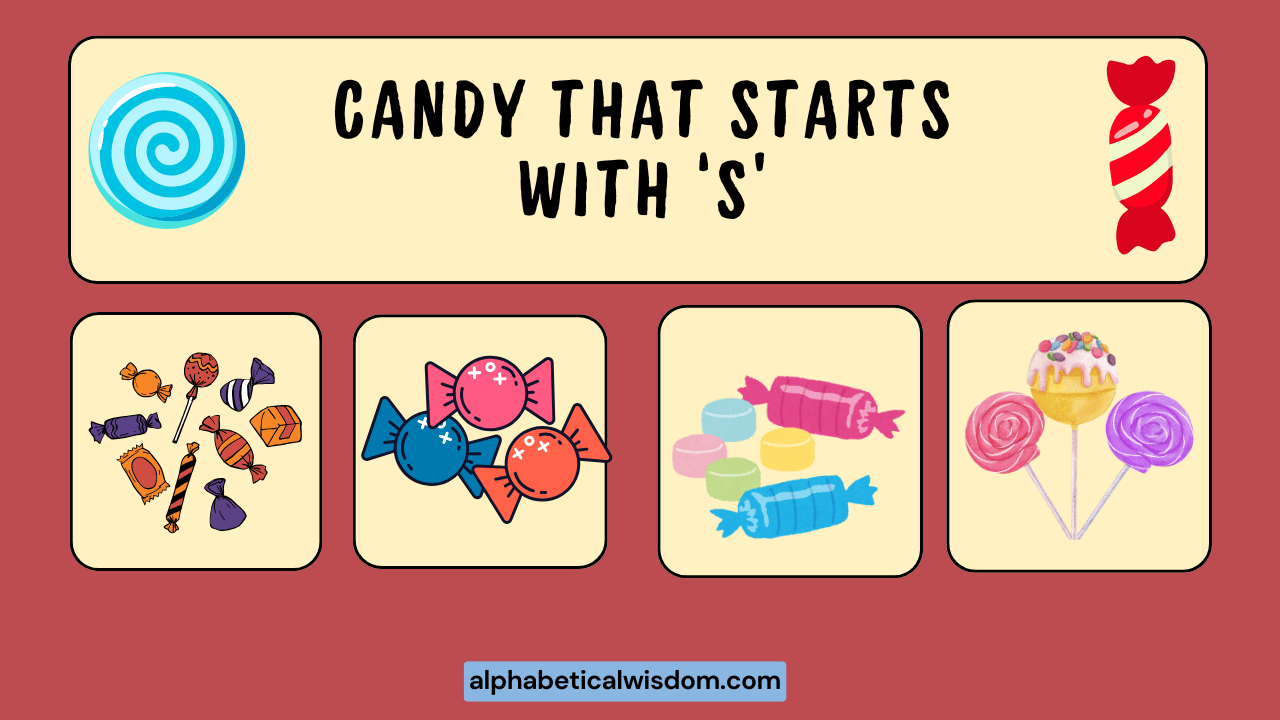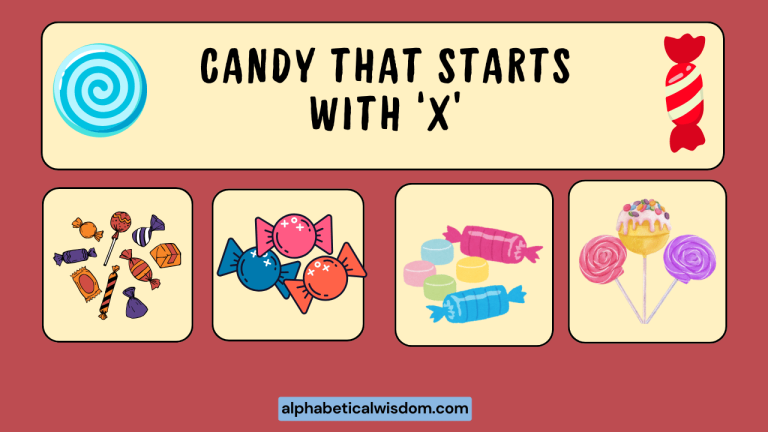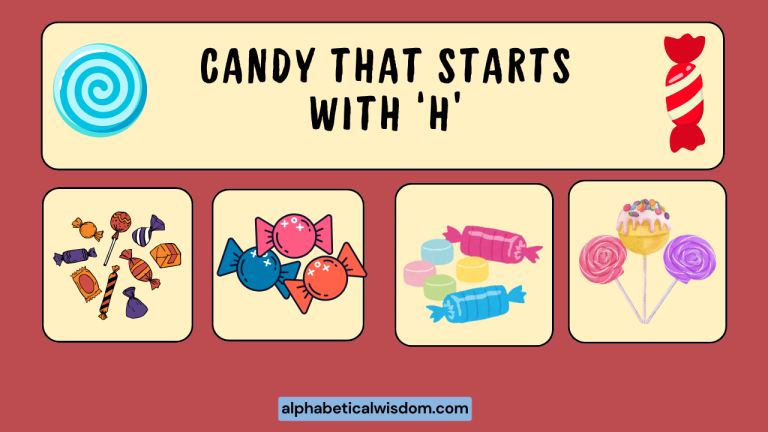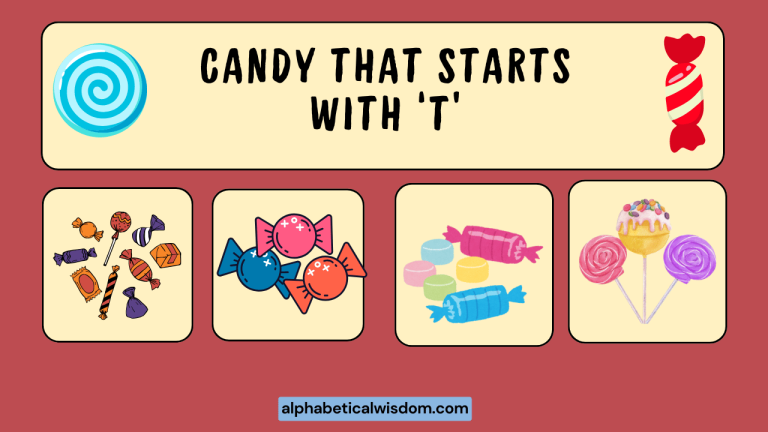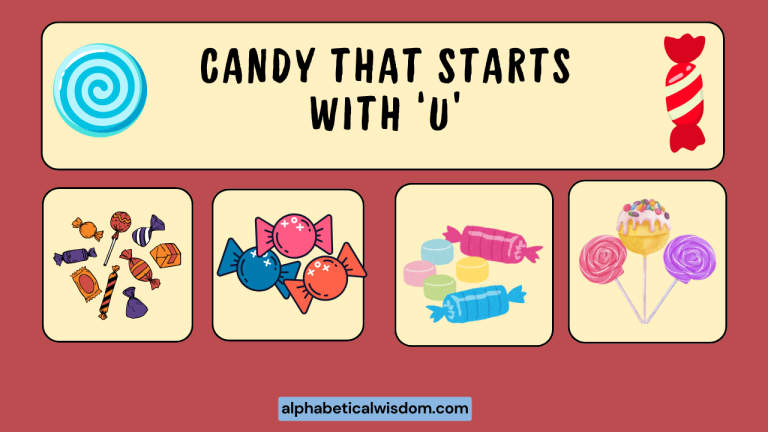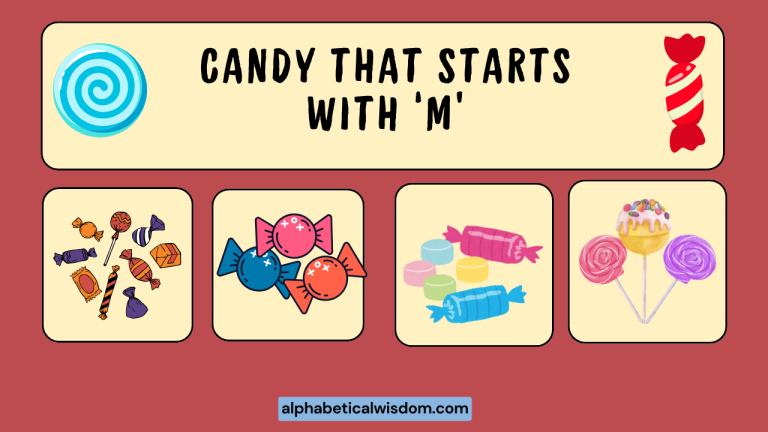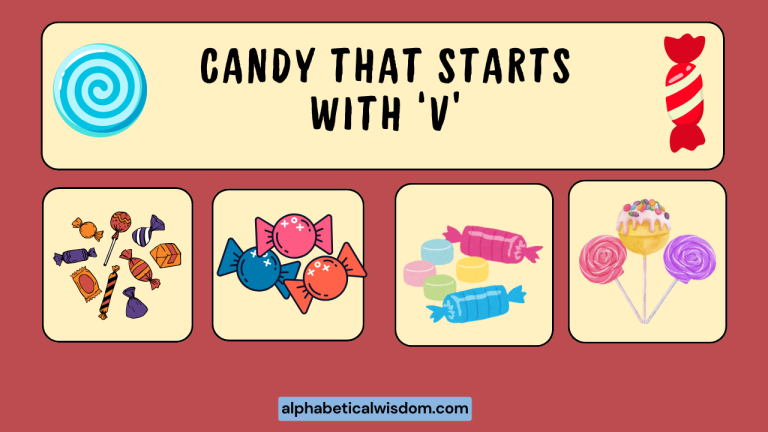Sweet Sentences: Mastering Nouns Starting with “Candy”
Understanding how to use nouns, especially in specific categories like those related to “candy,” is crucial for effective communication. This article explores the nuances of using nouns that begin with “candy,” focusing on their grammatical roles and diverse applications.
Whether you’re an English language learner, a student brushing up on grammar, or simply someone who enjoys the sweet side of language, this guide will provide you with the knowledge and practice needed to confidently incorporate these nouns into your vocabulary and writing.
Table of Contents
- Introduction
- Definition of Nouns Starting with “Candy”
- Structural Breakdown
- Types and Categories
- Examples
- Usage Rules
- Common Mistakes
- Practice Exercises
- Advanced Topics
- FAQ
- Conclusion
Definition of Nouns Starting with “Candy”
A noun is a word that represents a person, place, thing, or idea. When we focus on nouns starting with “candy,” we are primarily dealing with tangible objects – specific types of sweets and confections.
These nouns function like any other noun in English, serving as subjects, objects, complements, or objects of prepositions within a sentence. Understanding their specific meanings and applications enhances vocabulary and improves clarity in both written and spoken communication.
Nouns that begin with “candy” fall under the broader category of count nouns, meaning they can be singular or plural. They can also be modified by adjectives to provide more detailed descriptions, and they can be used in various grammatical structures to convey different meanings and relationships within a sentence.
The context in which these nouns are used often dictates the specific form and function they take.
Structural Breakdown
The structure of sentences using nouns starting with “candy” follows standard English grammar rules. These nouns can be the subject of a sentence, performing an action. For example, “Candy canes are popular during Christmas.” Here, “candy canes” is the subject. They can also be the object of a verb, receiving the action. For instance, “I bought candy today.” In this case, “candy” is the object of the verb “bought.” Furthermore, they can function as the object of a preposition, such as “He hid the sweets under the candy dish.” Here, “candy dish” is the object of the preposition “under.” The correct placement and usage of these nouns are essential for constructing grammatically sound and meaningful sentences.
Understanding the structural role of nouns starting with “candy” also involves recognizing their potential for modification. Adjectives can be used to describe the candy, adding detail and specificity. For example, “The sour candy made my face pucker.” Here, “sour” modifies “candy.” Additionally, these nouns can be part of compound nouns, creating more complex terms like “candy store” or “candy apple.” These compound nouns function as single units, representing specific entities or concepts.
Types and Categories
Nouns starting with “candy” can be categorized into several types based on their specific meanings and usage. These categories help to organize and understand the diverse range of sweets that fall under this umbrella.
We can broadly classify them into specific types of candies and related terms that involve candy.
Specific Candies
This category includes the names of individual types of candy, such as “candy cane,” “candy corn,” and “candy bar.” Each of these nouns refers to a specific confection with unique characteristics and ingredients. These nouns are often used in everyday conversation and writing to describe or refer to particular sweets.
Understanding the specific meanings of these terms is crucial for accurate and effective communication.
Consider these examples: “She loves candy canes during the holidays.” “Candy corn is a popular Halloween treat.” “He ate a whole candy bar after dinner.” These sentences illustrate how specific candy names function as nouns within different contexts, conveying clear and precise information about the types of sweets being discussed.
Related Terms
This category encompasses terms that are related to candy but do not necessarily refer to specific types of sweets. These can include “candy store,” “candy dish,” and “candy wrapper.” These nouns often describe places, containers, or objects associated with candy.
They contribute to a broader understanding of the candy-related vocabulary and its various applications.
For instance: “The children ran to the candy store.” “The candy dish was filled with colorful chocolates.” “He crumpled up the candy wrapper and threw it away.” These examples show how related terms function as nouns, providing context and detail about the environment and accessories associated with candy consumption and storage.
Examples
To further illustrate the usage of nouns starting with “candy,” let’s examine several examples in different sentence structures. These examples will demonstrate how these nouns function as subjects, objects, and complements, and how they can be modified by adjectives to add detail and specificity.
Simple Sentences
Simple sentences are the foundation of clear communication. They typically consist of a subject and a verb, and can include nouns starting with “candy” in various roles.
The following table provides examples of simple sentences using nouns starting with “candy”:
| Sentence | Noun Starting with “Candy” | Function |
|---|---|---|
| Candy is sweet. | Candy | Subject |
| I like candy. | Candy | Object |
| The store sells candy. | Candy | Object |
| Candy canes are festive. | Candy canes | Subject |
| She ate a candy apple. | Candy apple | Object |
| The candy dish is full. | Candy dish | Subject |
| He found a candy wrapper. | Candy wrapper | Object |
| Candy corn is colorful. | Candy corn | Subject |
| They visited the candy store. | Candy store | Object |
| The gift was candy. | Candy | Complement |
| Halloween means candy. | Candy | Complement |
| This candy is delicious. | Candy | Subject |
| I prefer hard candy. | Candy | Object |
| She makes candy. | Candy | Object |
| The box contains candy. | Candy | Object |
| Candy is tempting. | Candy | Subject |
| He craves candy. | Candy | Object |
| The prize was candy. | Candy | Complement |
| Kids love candy. | Candy | Object |
| This is candy. | Candy | Complement |
Complex Sentences
Complex sentences combine an independent clause with one or more dependent clauses. This allows for more detailed and nuanced expressions involving nouns starting with “candy”.
Here are some examples:
| Sentence | Noun Starting with “Candy” | Clause Type |
|---|---|---|
| Because she loves candy, she goes to the store every day. | Candy | Dependent Clause |
| I bought candy after I finished my homework. | Candy | Independent Clause |
| He ate the candy that his mother gave him. | Candy | Independent Clause |
| Although candy canes are seasonal, they are always delicious. | Candy canes | Dependent Clause |
| She enjoys candy apples when she visits the fair. | Candy apples | Independent Clause |
| The candy dish, which was made of glass, was very fragile. | Candy dish | Independent Clause |
| He threw away the candy wrapper because it was sticky. | Candy wrapper | Independent Clause |
| Candy corn, which is a Halloween staple, is often debated. | Candy corn | Independent Clause |
| They went to the candy store so they could buy their favorite sweets. | Candy store | Independent Clause |
| If you want candy, you should ask your parents. | Candy | Independent Clause |
| The candy, which I bought yesterday, is already gone. | Candy | Independent Clause |
| Before eating the candy, he checked the ingredients. | Candy | Independent Clause |
| She hid the candy where no one could find it. | Candy | Independent Clause |
| Unless you finish your dinner, you won’t get any candy. | Candy | Independent Clause |
| While the candy is tempting, it’s important to eat healthy. | Candy | Independent Clause |
| After the movie, we went to get candy. | Candy | Independent Clause |
| Although she loves candy, she tries to limit her intake. | Candy | Independent Clause |
| Because the candy was on sale, I bought a lot. | Candy | Independent Clause |
| Since it’s Halloween, everyone is giving out candy. | Candy | Independent Clause |
| As soon as he saw the candy, he grabbed it. | Candy | Independent Clause |
Descriptive Sentences
Descriptive sentences use adjectives and adverbs to provide more detail about the nouns starting with “candy”. This allows for more vivid and engaging communication.
Consider these examples:
| Sentence | Noun Starting with “Candy” | Descriptive Words |
|---|---|---|
| The delicious candy was brightly colored. | Candy | Delicious, brightly |
| She bought a large candy bar at the store. | Candy bar | Large |
| The old candy dish was filled with colorful chocolates. | Candy dish | Old, colorful |
| Striped candy canes are a Christmas tradition. | Candy canes | Striped |
| The sticky candy wrapper clung to his fingers. | Candy wrapper | Sticky |
| Tri-colored candy corn is a popular Halloween treat. | Candy corn | Tri-colored |
| The charming candy store was filled with sweet aromas. | Candy store | Charming, sweet |
| The sour candy made her face pucker. | Candy | Sour |
| He unwrapped the shiny candy. | Candy | Shiny |
| The homemade candy was the best. | Candy | Homemade |
| The minty candy refreshed her breath. | Candy | Minty |
| She chose a gummy candy. | Candy | Gummy |
| The chocolate candy melted in his hand. | Candy | Chocolate |
| He preferred hard candy. | Candy | Hard |
| The sweet candy attracted ants. | Candy | Sweet |
| She offered a colorful candy. | Candy | Colorful |
| The imported candy was expensive. | Candy | Imported |
| He savored the rich candy. | Candy | Rich |
| The chewy candy stuck to her teeth. | Candy | Chewy |
| She shared the delicious candy. | Candy | Delicious |
Usage Rules
Proper usage of nouns starting with “candy” involves understanding the rules of pluralization, article usage, and possessive forms. These rules ensure grammatical accuracy and clarity in communication.
Pluralization
Most nouns starting with “candy” follow standard pluralization rules, adding an “-s” to the end of the word. For example, “candy” becomes “candies,” “candy bar” becomes “candy bars,” and “candy cane” becomes “candy canes.” However, some compound nouns may have irregular plural forms.
For instance, while “candy store” can be pluralized as “candy stores,” it’s essential to be aware of these variations to avoid errors.
Here’s a table illustrating the pluralization of nouns starting with “candy”:
| Singular | Plural |
|---|---|
| Candy | Candies |
| Candy bar | Candy bars |
| Candy cane | Candy canes |
| Candy apple | Candy apples |
| Candy dish | Candy dishes |
| Candy wrapper | Candy wrappers |
| Candy corn | Candy corns |
| Candy store | Candy stores |
Articles (a, an, the)
The use of articles (a, an, the) with nouns starting with “candy” depends on whether the noun is specific or general. Use “a” or “an” for singular, non-specific candies (e.g., “a candy bar,” “an assortment of candies”).
Use “the” for specific candies or when referring to a particular instance (e.g., “the candy I bought,” “the candy store on Main Street”). When referring to candy in general, no article is needed (e.g., “Candy is sweet.”).
Here’s a table demonstrating the correct usage of articles with nouns starting with “candy”:
| Article | Example | Explanation |
|---|---|---|
| A | I ate a candy bar. | Refers to a non-specific candy bar. |
| An | She offered an assortment of candies. | Refers to a non-specific assortment. |
| The | The candy I bought was delicious. | Refers to a specific candy. |
| No article | Candy is bad for your teeth. | Refers to candy in general. |
Possessives
To show possession with nouns starting with “candy,” use the possessive form (‘s). For singular nouns, add ‘s (e.g., “the candy’s sweetness”).
For plural nouns ending in -s, add only an apostrophe (e.g., “the candies’ flavors”). For plural nouns not ending in -s, add ‘s (e.g., “the children’s candy”).
Here’s a table illustrating the possessive forms of nouns starting with “candy”:
| Noun | Possessive Form | Example |
|---|---|---|
| Candy | Candy’s | The candy’s sweetness was overwhelming. |
| Candies | Candies’ | The candies’ flavors were diverse. |
| Candy store | Candy store’s | The candy store’s window display was tempting. |
Common Mistakes
One common mistake is incorrect pluralization, such as saying “candys” instead of “candies.” Another error is misusing articles, for example, saying “I want the candy” when referring to candy in general. Additionally, incorrect possessive forms, like “candy’ sweetness” instead of “candy’s sweetness,” are frequent errors.
Being aware of these common mistakes can help learners avoid them and improve their grammatical accuracy.
The following table highlights some common mistakes and their corrections:
| Incorrect | Correct | Explanation |
|---|---|---|
| I want candys. | I want candies. | Correct plural form. |
| Candy is the good. | Candy is good. | Article unnecessary when referring to candy in general. |
| Candy’ sweetness. | Candy’s sweetness. | Correct possessive form. |
| A candy canes. | Candy canes. | Incorrect use of article with plural noun. |
| The candy I want is candies. | The candy I want is candy. | Unnecessary pluralization. |
Practice Exercises
To reinforce your understanding of nouns starting with “candy,” complete the following exercises. These exercises will test your knowledge of pluralization, article usage, possessive forms, and sentence construction.
Exercise 1: Fill in the Blanks
Fill in the blanks with the correct form of the noun starting with “candy.”
| Question | Answer |
|---|---|
| 1. She bought several __________ for the party. (candy bar) | candy bars |
| 2. The __________ window was decorated for Halloween. (candy store) | candy store’s |
| 3. __________ is often given out on Halloween. (candy) | Candy |
| 4. He found a __________ in his pocket. (candy wrapper) | candy wrapper |
| 5. __________ are a popular Christmas treat. (candy cane) | Candy canes |
| 6. The __________ sweetness was irresistible. (candy) | candy’s |
| 7. She loves __________ more than anything. (candy) | candy |
| 8. He dropped the __________ on the floor. (candy dish) | candy dish |
| 9. __________ is a controversial Halloween treat. (candy corn) | Candy corn |
| 10. The __________ selection was impressive. (candy store) | candy store’s |
Exercise 2: Sentence Construction
Construct sentences using the given nouns starting with “candy” and the specified grammatical structure.
| Noun | Instruction | Example Answer |
|---|---|---|
| Candy | Use as the subject of a simple sentence. | Candy is delicious. |
| Candy bar | Use as the object of a verb in a complex sentence. | I ate the candy bar that I bought yesterday. |
| Candy cane | Use in a descriptive sentence with an adjective. | The striped candy cane was festive. |
| Candy dish | Use as the object of a preposition. | The keys are beside the candy dish. |
| Candy wrapper | Use in a sentence showing possession. | The candy wrapper’s colors were bright. |
| Candy corn | Use in a sentence with a dependent clause. | Although candy corn is sweet, some people don’t like it. |
| Candy store | Use as the subject of a sentence with an adjective. | The charming candy store attracted many customers. |
| Candy | Use in a sentence with an article. | The candy was expensive. |
| Candy | Use as a complement in a sentence. | The prize was candy. |
| Candy bar | Use in sentence with “a” article. | I want a candy bar. |
Advanced Topics
For advanced learners, exploring the etymology of “candy” and its variations across different languages can be insightful. Additionally, analyzing the use of candy-related metaphors and idioms in literature and everyday speech can provide a deeper understanding of the cultural significance of candy.
Examining the grammatical nuances of compound nouns like “candy-coated” or “candy-striped” can also enhance linguistic proficiency.
Understanding the historical context of certain candy names, such as how “candy cane” evolved from a simple white stick to a peppermint-flavored, striped treat, can add depth to one’s knowledge. Furthermore, studying how different cultures perceive and integrate candy into their traditions and celebrations can broaden linguistic and cultural awareness.
FAQ
- What is the difference between “candy” and “candies”?
“Candy” is generally used as an uncountable noun when referring to candy in general. “Candies” is the plural form, used when referring to multiple individual pieces or types of candy. For example, “Candy is sweet” refers to candy in general, while “I bought several candies” refers to multiple individual sweets.
- When should I use “a” vs. “an” before a noun starting with “candy”?
Use “a” before nouns that begin with a consonant sound (e.g., “a candy bar”). Use “an” before nouns that begin with a vowel sound (e.g., “an assortment of candies”). Note that it’s the sound, not the letter, that determines the choice of article.
- How do I form the possessive of a plural noun starting with “candy”?
For plural nouns ending in “-s,” add only an apostrophe (‘). For example, “The candies’ flavors” indicates that the flavors belong to the candies. For plural nouns not ending in “-s,” add ‘s (e.g., “the children’s candy”).
- Can “candy” be used as a verb?
While “candy” is primarily used as a noun, it can be used as a verb, although this is less common. To “candy” something means to coat it with sugar or syrup. For example, “She candied the apples for the fair.”
- Is “candy corn” one word or two?
“Candy corn” is typically written as two separate words. It refers to a specific type of candy that resembles corn kernels and is popular during Halloween.
- How do I use “candy” in compound nouns?
“Candy” can be used in compound nouns to describe places, objects, or actions related to candy. Examples include “candy store,” “candy dish,” and “candy-coated.” These compound nouns function as single units and have specific meanings.
- What are some common idioms involving “candy”?
One common idiom is “like taking candy from a baby,” which means something is very easy to do. Another is “eye candy,” which refers to something visually appealing but often superficial.
- How do I correct the sentence ‘I want candys’?
The correct sentence is “I want candies.” The plural form of “candy” is “candies,” not “candys.”
- Can I say ‘a candy’ or should I always use ‘some candy’?
While “candy” is generally treated as an uncountable noun, you can use “a piece of candy” to refer to a single unit. Using “some candy” is also correct and refers to an unspecified amount of candy.
Conclusion
Mastering the usage of nouns starting with “candy” involves understanding their grammatical roles, pluralization rules, article usage, and possessive forms. By studying examples, practicing exercises, and being aware of common mistakes, learners can confidently incorporate these nouns into their vocabulary and writing.
This knowledge enhances clarity and precision in communication, whether in everyday conversation or formal writing.
Remember to pay attention to the context in which these nouns are used, and to practice regularly to reinforce your understanding. By doing so, you’ll be able to navigate the sweet side of language with ease and accuracy.
Consistent practice and attention to detail are key to mastering these concepts and achieving fluency in English.
